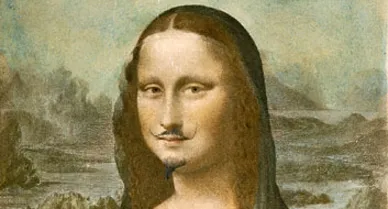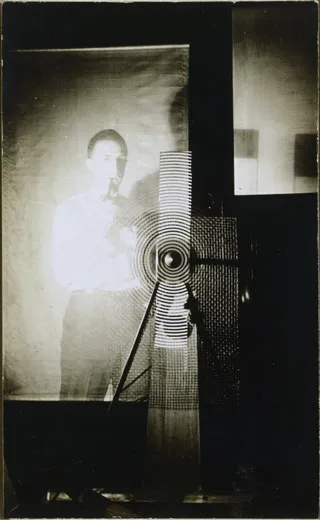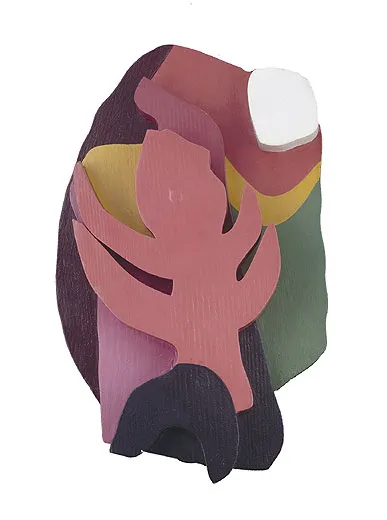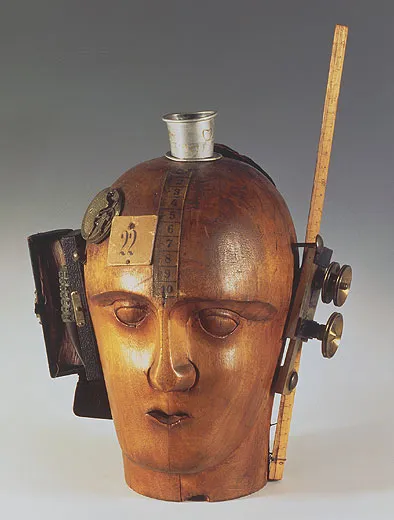Which Dadaist Idea Would Have a Radical Influence on Art of the Later Twentieth Century?
In the years earlier World War I, Europe appeared to exist losing its concord on reality. Einstein's universe seemed like scientific discipline fiction, Freud'southward theories put reason in the grip of the unconscious and Marx's Communism aimed to turn guild upside down, with the proletariat on top. The arts were also coming unglued. Schoenberg's music was atonal, Mal-larmé's poems scrambled syntax and scattered words across the page and Picasso's Cubism made a hash of homo beefcake.
And even more radical ideas were afoot. Anarchists and nihilists inhabited the political fringe, and a new breed of artist was starting to assail the very concept of art itself. In Paris, afterward trying his hand at Impressionism and Cubism, Marcel Duchamp rejected all painting because it was made for the eye, not the heed.
"In 1913 I had the happy idea to fasten a wheel wheel to a kitchen stool and scout it plow," he after wrote, describing the construction he called Bicycle Wheel, a precursor of both kinetic and conceptual art. In 1916, German writer Hugo Ball, who had taken refuge from the war in neutral Switzerland, reflected on the country of contemporary art: "The prototype of the homo form is gradually disappearing from the painting of these times and all objects appear only in fragments....The next step is for poetry to determine to do away with language."
That same twelvemonth, Brawl recited just such a poem on the stage of the Cabaret Voltaire in Zurich, a nightspot (named for the 18th-century French philosopher and satirist) that he, Emmy Hennings (a vocalist and poet he would later marry) and a few expatriate pals had opened every bit a gathering place for artists and writers. The verse form began: "gadji beri bimba / glandridi lauli lonni cadori...." It was utter nonsense, of grade, aimed at a public that seemed all too conceited about a senseless war. Politicians of all stripes had proclaimed the war a noble cause—whether information technology was to defend Germany's loftier culture, French republic'southward Enlightenment or Great britain'south empire. Ball wanted to stupor anyone, he wrote, who regarded "all this civilized carnage every bit a triumph of European intelligence." One Cabaret Voltaire performer, Romanian creative person Tristan Tzara, described its nightly shows as "explosions of elective imbecility."
This new, irrational art motion would exist named Dada. Information technology got its proper name, according to Richard Huelsenbeck, a German artist living in Zurich, when he and Brawl came upon the discussion in a French-High german dictionary. To Brawl, it fit. "Dada is 'yes, yep' in Rumanian, 'rocking horse' and 'hobby horse' in French," he noted in his diary. "For Germans it is a sign of foolish naiveté, joy in procreation, and preoccupation with the babe carriage." Tzara, who later claimed that he had coined the term, quickly used it on posters, put out the get-go Dada periodical and wrote i of the get-go of many Dada manifestoes, few of which, appropriately enough, made much sense.
But the absurdist outlook spread similar a pandemic—Tzara called Dada "a virgin microbe"—and at that place were outbreaks from Berlin to Paris, New York and even Tokyo. And for all its zaniness, the motility would prove to be ane of the most influential in modern art, foreshadowing abstract and conceptual fine art, functioning art, op, popular and installation art. But Dada would die out in less than a decade and has not had the kind of major museum retrospective it deserves, until now.
The Dada exhibition at the National Gallery of Art in Washington, D.C. (on view through May xiv) presents some 400 paintings, sculptures, photographs, collages, prints, and motion picture and sound recordings by more than than twoscore artists. The prove, which moves to New York'south Museum of Modern Art (June 18 through September 11), is a variation on an even larger exhibition that opened at the Pompidou Centre in Paris in the fall of 2005. In an attempt to make Dada easier to understand, the American curators, Leah Dickerman, of the National Gallery, and Anne Umland, of MoMA, take organized it around the cities where the movement flourished—Zurich, Berlin, Hanover, Cologne, New York and Paris.
Dickerman traces Dada's origins to the Great War (1914-18), which left 10 million dead and some 20 million wounded. "For many intellectuals," she writes in the National Gallery catalog, "Globe War I produced a collapse of confidence in the rhetoric—if not the principles—of the civilisation of rationality that had prevailed in Europe since the Enlightenment." She goes on to quote Freud, who wrote that no event "confused so many of the clearest intelligences, or so thoroughly debased what is highest." Dada embraced and parodied that confusion. "Dada wished to replace the logical nonsense of the men of today with an illogical nonsense," wrote Gabrielle Buffet-Picabia, whose artist married man, Francis Picabia, in one case tacked a stuffed monkey to a board and called information technology a portrait of Cézanne.
"Total pandemonium," wrote Hans Arp, a immature Alsatian sculptor in Zurich, of the goings-on at the "gaudy, motley, overcrowded" Cabaret Voltaire. "Tzara is wiggling his behind like the belly of an Oriental dancer. Janco is playing an invisible violin and bowing and scraping. Madame Hennings, with a Madonna face, is doing the splits. Huelsenbeck is banging away nonstop on the great drum, with Ball accompanying him on the piano, pale as a chalky ghost."
These antics struck the Dada crowd as no more than absurd than the war itself. A swift German offensive in April 1917 left 120,000 French dead simply 150 miles from Paris, and one village witnessed a band of French infantrymen (sent as reinforcements) baa-ing like lambs led to slaughter, in futile protestation, every bit they were marched to the front. "Without World War I there is no Dada," says Laurent Le Bon, the curator of the Pompidou Heart's testify. "Only there's a French saying, 'Dada explains the state of war more than the war explains Dada.'"
Ii of Deutschland's military leaders had dubbed the state of war "Materialschlacht," or "the battle of equipment." Only the dadas, as they called themselves, begged to differ. "The state of war is based on a crass mistake," Hugo Ball wrote in his diary on June 26, 1915. "Men have been mistaken for machines."
Information technology was not only the state of war only the impact of modern media and the emerging industrial historic period of science and technology that provoked the Dada artists. As Arp once complained, "Today'due south representative of man is but a tiny button on a giant senseless machine." The dadas mocked that dehumanization with elaborate pseudodiagrams—chockablock with gears, pulleys, dials, wheels, levers, pistons and clockworks—that explained goose egg. The typographer's symbol of a pointing hand appeared oftentimes in Dada fine art and became an emblem for the move—making a pointless gesture. Arp created abstract compositions from cutout newspaper shapes, which he dropped randomly onto a background and glued downwardly where they cruel. He argued for this kind of gamble abstraction every bit a style to rid art of whatsoever subjectivity. Duchamp found a unlike way to make his art impersonal—drawing like a mechanical engineer rather than an artist. He preferred mechanical drawing, he said, because "information technology'southward exterior all pictorial convention."
When Dadaists did choose to represent the man form, it was oftentimes mutilated or made to look manufactured or mechanical. The multitude of severely bedridden veterans and the growth of a prosthetics industry, says curator Leah Dickerman, "struck contemporaries every bit creating a race of one-half-mechanical men." Berlin artist Raoul Hausmann fabricated a Dada icon out of a wig-maker'due south dummy and various oddments—a crocodile-skin wallet, a ruler, the mechanism of a pocket sentry—and titled it Mechanical Head (The Spirit of Our Age). Two other Berlin artists, George Grosz and John Heartfield, turned a life-size tailor's dummy into a sculpture by calculation a revolver, a doorbell, a knife and fork and a German Army Fe Cantankerous; they gave it a working light bulb for a head, a pair of dentures at the crotch and a lamp stand as an bogus leg.
Duchamp traced the roots of Dada'due south farcical spirit dorsum to the fifth-century b.c. Greek satirical playwright Aristophanes, says the Pompidou Center's Le Bon. A more immediate source, however, was the absurdist French playwright Alfred Jarry, whose 1895 farce Ubu Roi (Male monarch Ubu) introduced "'Pataphysics"—"the science of imaginary solutions." Information technology was the kind of scientific discipline that Dada applauded. Erik Satie, an advanced composer who collaborated with Picasso on phase productions and took part in Dada soirees, claimed that his sound collages—an orchestral suite with passages for piano and siren, for case—were "dominated by scientific thought."
Duchamp probably had the most success turning the tools of science into art. Born near Rouen in 1887, he had grown upwards in a bourgeois family unit that encouraged art—two older brothers and his younger sis as well became artists. His early paintings were influenced by Manet, Matisse and Picasso, but his Nude Descending a Staircase no. two (1912)—inspired by early cease-action photographic studies of motion—was entirely his own. In the painting, the female nude figure seems to take on the anatomy of a machine.
Rejected by the jury for the Salon des Independants of 1912 in Paris, the painting created a sensation in America when it was exhibited in New York Urban center at the 1913 Arsenal Testify (the land's beginning large-scale international exposition of modern art). Cartoon parodies of the work appeared in local papers, and one critic mocked it as "an explosion in a shingle factory." The Nude was snapped upward (for $240) by a collector, as were 3 other Duchamps. Two years after the prove, Duchamp and Picabia, whose paintings had likewise sold at the Armory Show, traded Paris for Manhattan. Duchamp filled his studio on West 67th Street with store-bought objects that he called "readymades"—a snowfall shovel, a hatrack, a metal canis familiaris comb. Explaining his selections some years later, he said: "You accept to arroyo something with an indifference, as if you had no aesthetic emotion. The choice of readymades is always based on visual indifference and, at the aforementioned fourth dimension, on the full absenteeism of good or bad taste." Duchamp didn't exhibit his readymades at first, but he saw in them notwithstanding another way to undermine conventional ideas almost art.
In 1917, he bought a porcelain urinal at a Fifth Avenue plumbing supply shop, titled it Fountain, signed information technology R. Mutt and submitted it to a Society of Contained Artists exhibition in New York Metropolis. Some of the show'due south organizers were aghast ("the poor fellows couldn't sleep for three days," Duchamp subsequently recalled), and the piece was rejected. Duchamp resigned as chairman of the exhibition commission in support of Mutt and published a defense of the work. The ensuing publicity helped make Fountain 1 of Dada's most notorious symbols, along with the print of Leonardo da Vinci'southward Mona Lisa the following year, to which Duchamp had added a penciled mustache and goatee.
Parodying the scientific method, Duchamp fabricated voluminous notes, diagrams and studies for his near enigmatic work, The Bride Stripped Blank by Her Bachelors, Even (or The Large Glass)—a nine-pes-alpine assemblage of metal foil, wires, oil, varnish and dust, sandwiched between glass panels. Art historian Michael Taylor describes the work every bit "a complex allegory of frustrated desire in which the nine uniformed bachelors in the lower panel are perpetually thwarted from copulating with the wasplike, biomechanical bride to a higher place."
Duchamp's irreverence toward science was shared by ii of his New York companions, Picabia and a young American photographer, Man Ray. Picabia could draw with the precision of a commercial creative person, making his nonsensical diagrams seem peculiarly disarming. While Duchamp congenital machines with spinning disks that created surprising spiral patterns, Picabia covered canvases with disorienting stripes and concentric circles—an early course of optical experimentation in modern painting. Man Ray, whose photographs documented Duchamp's optical machines, put his own postage stamp on photography by manipulating images in the darkroom to create illusions on film.
Afterward the war ended in 1918, Dada disturbed the peace in Berlin, Cologne, Hanover and Paris. In Berlin, creative person Hannah Höch gave an ironic domestic touch to Dada with collages that incorporated sewing patterns, cutting-up photographs taken from fashion magazines and images of a German military and industrial society in ruins.
In Cologne, in 1920, German creative person Max Ernst and a band of local dadas, excluded from a museum exhibition, organized their own—"Dada Early Leap"—in the courtyard of a pub. Out past the men's room, a daughter wearing a "communion dress recited lewd poetry, thus assaulting both the sanctity of high art and of faith," art historian Sabine Kriebel notes in the current exhibition's catalog. In the courtyard, "viewers were encouraged to destroy an Ernst sculpture, to which he had attached a hatchet." The Cologne police shut down the prove, charging the artists with obscenity for a display of nudity. But the accuse was dropped when the obscenity turned out to be a print of a 1504 engraving by Albrecht Dürer titled Adam and Eve, which Ernst had incorporated into one of his sculptures.
In Hanover, artist Kurt Schwitters began making fine art out of the detritus of postwar Germany. "Out of parsimony I took whatever I found to do this," he wrote of the trash he picked upward off the streets and turned into collages and sculptural assemblages. "One can even shout with refuse, and this is what I did, nailing and gluing information technology together." Born the aforementioned year as Duchamp—1887—Schwitters had trained as a traditional painter and spent the state of war years equally a mechanical draftsman in a local ironworks. At the war'south finish, withal, he discovered the Dadaist movement, though he rejected the proper name Dada and came up with his own, Merz, a word that he cut out of an advert poster for Hanover's Kommerz-und Privatbank (a commercial bank) and glued into a collage. As the National Gallery's Dickerman points out, the word invoked not but money but also the German language word for pain, Schmerz, and the French word for excrement, merde. "A little money, a little pain, a petty sh-t," she says, "are the essence of Schwitters' fine art." The complimentary-form structure built out of found objects and geometric forms that the creative person called the Merzbau began equally a couple of three-dimensional collages, or assemblages, and grew until his house had become a construction site of columns, niches and grottoes. In fourth dimension, the sculpture actually broke through the edifice'due south roof and outer walls; he was withal working on information technology when he was forced to flee Federal republic of germany by the Nazis' rise to power. In the end, the work was destroyed by Allied bombers during World War Two.
Dada'due south last hurrah was sounded in Paris in the early 1920s, when Tzara, Ernst, Duchamp and other Dada pioneers took part in a series of exhibitions of provocative art, nude performances, rowdy stage productions and incomprehensible manifestoes. Just the movement was falling apart. The French critic and poet André Breton issued his own Dada manifestoes, but fell to feuding with Tzara, as Picabia, fed up with all the infighting, fled the scene. By the early 1920s Breton was already hatching the adjacent great avant-garde thought, Surrealism. "Dada," he gloated, "very fortunately, is no longer an result and its funeral, about May 1921, caused no rioting."
Only Dada, which wasn't quite dead yet, would shortly spring from the grave. Arp's abstractions, Schwitters' constructions, Picabia'south targets and stripes and Duchamp's readymades were soon turning up in the work of major 20th-century artists and fine art movements. From Stuart Davis' abstractions to Andy Warhol'south Popular Art, from Jasper Johns' targets and flags to Robert Rauschenberg's collages and combines—virtually anywhere you look in mod and contemporary art, Dada did it offset. Even Breton, who died in 1966, recanted his disdain for Dada. "Fundamentally, since Dada," he wrote, not long before his death, "we accept done nil."
Source: https://www.smithsonianmag.com/arts-culture/dada-115169154/




0 Response to "Which Dadaist Idea Would Have a Radical Influence on Art of the Later Twentieth Century?"
Post a Comment